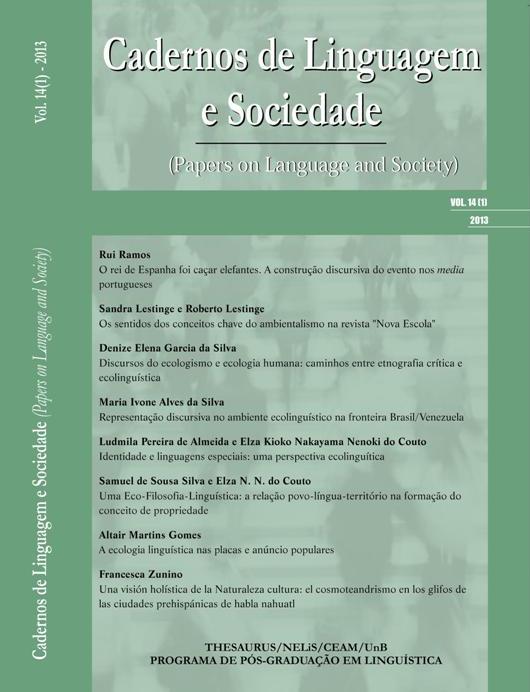UNA VISIÓN HOLÍSTICA DE LA NATURALEZACULTURA: EL COSMOTEANDRISMO EN LOS GLIFOS DE LAS CIUDADES PREHISPÁNICAS DE HABLA NAHUATL
DOI:
https://doi.org/10.26512/les.v14i1.22226Keywords:
Holims. Natureculture. Cosmoteandrism. Integration. PreHispanic. Nahuatl.Abstract
The issues concerning the overcoming of the false dichotomy between
the two apparently opposite concepts of “nature” and “culture”
represent the central and most urgent core of both Ecolinguistics’
integrated standpoint and global society’s general discourse. In order to
eclipse this separation, which is the most damaging for the anthropoecosystem among the basic contradictions of our social praxis (Ibid.),
our cognitive, discursive and performative perspective needs a radical
change. This transformation shall involve the use of new terms and
references that holistically illustrate the consubstantial inter-relation
between the “human” and the “natural” being - that is, of all planet’s
being -, such as the “natureculture” neologism. The present analysis
aims at applying the triadic perspective of cosmoteandrism ”“ the
ecosophic integration among the cosmic, the human and the devine in
the eprception of reality, of being and of the planet ”“ to Ecolinguistic
studies, investigating how the union among the anthropological, natural
and teological dimensions is represented in the discourse of the Nahuatl
speaking populations of pre-Hispanic Mexico; and specifically, in the
ethnotoponymy and in the visual representations of the glyphs indicating
the pre-Columbian cities and geographic locations. A new diachronic
philosophically and ecologically integrated construction of narratives and identities, a new “greenspeak” or better a new “ecological speaking”
which shall be applicable, alternative and constructive (following the
four macro-strategies classification of discourse construction, van
Leeuwen y Wodak, 1999), must also start with the search and use of
languages and imageries originating in non-Eurocentric world visions,
and therefore less prejudiced by the harmful dualism that characterizes
the Standard Average European languages), exported and used since the
colonial period.
Downloads
References
AINSA, F. Del topos al logos. Propuestas de geopoética. Madrid-Frankfurt am Main: Vervuert, [1976] 2006.
ALEXANDER, R. Framing Discourse on the Environment. A Critical Discourse Analysis Approach. Londres: Routledge, 2009.
AMITH, J.D. Enciclopedia Cultural Náhuatl: Botánica y Zoología, Río Balsas, Guerrero. FAMSI, Foundation for the Advancement of Mesoamerican Studies, Inc., 2007, pp.1-74, solo edición digital, www.famsi.org/reports/03049es/03049esAmith01.pdf.
ASTURIAS, M.A. Hombres de maíz. Madrid: Alianza Editorial, [1949] 1972.
BANG, J.C. The ecology of communicative competence. In: A. FILL; H. PENZ (org.) Sustaining language: essays in Applied Ecolinguistics, 2007, pp. 251-265. Tübingen:LIT Verlag.
BANG, J.C.; DØØR, J. Eco-linguistics: a framework. In: AILA 1993: 31-40. Edición digital, http://www.jcbang.dk/main/ecolinguistics/Ecoling_AFramework1993.pdf.
BANG, J. C.; DØØR, J. Dialectics, Ecology, and Order. In: B. KETTEMANN; H. PENZ (org.) ECOnstructing language, nature and society: the ecolinguistic project revisited; essays in honour of Alwin Fill. Tübingen : Stauffenburg, 2000: 49-62.
BANG, J.C.; DØØR, J.; NASH, J.; STEFFENSEN, S.V. Language, ecology and society: a dialectical approach. Londres: Continuum, 2008.
BARLOW, R. H. The Extent of the Empire of the Culhua Mexica. Berkeley, University of California Press, 1949.
BARTHES, R. Rhétorique de l’image. Communications, 4 : 40-51, 1964.
BARTRA, A. Del teocintle a los corn pops. In: G. ESTEVA; C. MARIELLE (org.) Sin maíz no hay país. México, DF: Conaculta, 2003, pp. 219-249.
BASTARDAS i BOADA, A. Linguistic sustainability and language ecology. Journal of Language & Ecology, 1,4, 2005, solo edición digital, http://www.ecoling.net/Sustainability.pdf.
BASTARDAS i BOADA, A. Complejidad y emergencia en lingüística y ciencias de la comunicación. Glossa. An Ambilingual Interdisciplinary Journal, 4,2: 312”“330, 2009. Edición digital, http://bibliotecavirtualut.suagm.edu/Glossa2/Journal/Oct2009/Complejidad-y-Emergencia.pdf.
BAY D.; DØØR J.; STEFFENSEN, S.V. Modality, ecology, metaphor. metaphorik.de, 4, 2003, solo edición digital, http://www.metaphorik.de/04/baydoorsteffensen.htm.
BOFF, L. Ecologia, mondialità , mistica. Assisi: Cittadella Editore, 1993.
BOWERS, C.A. Philosophy, language and the Titanic mind-set. Language & Ecology, 2, 1, 2007, solo edición digital, http://www.ecoling.net/titanic.pdf.
BRODA, J. Simbolismo de los volcanes. Los volcanes en la cosmovisión mexicana. Arqueología Mexicana, XVI, 95: 40-47, 2009.
BRODA, J.; IWANISZEWSKI. S.; MONTERO GARCÃA, I.A. La montaña en el paisaje ritual. México, DF: UNAM, 2001.
CARRASCO, D. Cosmic Jaws: We Eat the Gods and the Gods Eat Us. Journal of the American Academy of Religion, 63, 3: 429-463, 1995.
CASILLAS C.; LETICIA E.; VARGAS, L. A. La alimentación entre los mexicas. In: F. MARTÃNEZ CORTÉS (org.) Historia general de la medicina en México, Tomo 1. México, DF: UNAM, 1984, pp. 13-156COE, M. D. Mexico. From the Olmecs to the Aztecs. Londres: Thames and Hudson, [1962] 1994.
COOKE, R. Human settlement of Central America and northernmost South America (14,000”“8000 BP). Quaternary International, 49/50:177”“190, 1998.
COUTO, H. H. do. Ecolingüística. Estudio das relações entre língua e meio ambiente. Brasília: Thesaurus, 2007.
COUTO, H. H. Ecological approaches in linguistics: a historical overview. Language sciences, Special Issue, Ecolinguistics: the Ecology of Language and Science, en prensa.
DABROWSKA, K.M. El concepto de ilhuicatl en la cosmovisión nahua y sus representaciones gráficas en códices. Revista española de antropología americana, 38, 2:151-171, 2008.
DILLEHAY, T.D. The Settlement of the Americas: A New Prehistory. New York: Basic Books, 2000.
DÖRING, M., 2003. The Politics of Nature. Constructing the German Reunification During the Great Odra Flood 1997. Environment and History, 9: 195-214.
DULL, R. The maize revolution: a view from El Salvador. In: J. Staller; R. TYKOT; B. BENZ (org.) Histories of maize. Oxford: Elsevier, 2006, pp. 357-366.
DULL, R. Unpacking El Salvador’s ecological predicament: Theoreticaltemplates and ‘‘long-view’’ ecologies. Global Environmental Change, 18: 319”“329, 2008.
Fairclough, N. Language and power. Harlow: Pearson Education Limited, 2001.
Fairclough, N. Analyzing discourse: textual analysis for social research. Londres: Routledge, 2003.
FAUCONNIER, G.; TURNER, M. The way we think. Conceptual blendings and the mind’s hidden complexities. New York: Basic Books, 2002.
FERNÁNDEZ, A. Diccionario ritual de voces nahuas. México, DF: Panorama Editorial, 1992.
FILL, A. The language impact. Evolution-System-Discourse. Londres: Equinox, 2010.
FILL, A.; MÜHLHÄUSLER, P. (org.) The ecolinguistic reader. Language, ecology and environment. Londres: Continuum, 2001.
FLORESCANO, E. Sobre la naturaleza de los dioses de Mesoamérica. Estudios de cultura Náhuatl, 27: 41-67, 1997.
GAGLIASSO, E. Introduzione. Tra epistemologia e vissuto: il ruolo delle metafore del vivente. In: E. GAGLIASSO; G. FREZZA (org.) Metafore del vivente. Linguaggi e ricerca scientifica tra filosofia, bios e psiche. Milano: Franco Angeli, 2010, pp. 17-25.
GARCÃA COOK; A. Richard Stockton MacNeish y el origen de la agricultura. Arqueología Mexicana, V, 25: 40-43, 1997.
GLOTFELTY, C.; FROMM, H. The ecocriticism reader: landmarks in literary ecology. Athens: University of Georgia Press, 1996.
GOATLY, A. Green grammar and grammatial metaphor, or language and myth of power, or metaphors we die by. Journal of Pragmatics, 25: 537-560, 1996.
HALFFTER, G. La diversidad biológica de Iberomérica. Acta Zoologica Mexicana, Volumen Especial, 1992.
HALLYDAY, M.A.K. New ways of meaning. The challenge to Applied Linguistics. In: A. FILL; P. MÜHLHÄUSLER (org.) The ecolinguistic reader. Londres: Continuum, 2001.
HASLER HANGERT, A. Manual de gramática del nahuatl moderno. Tlaxcala: Universidad Autónoma de Tlaxcala, 1995.
HARRÉ, R.; BROCKMEIER, J.; MÜHLHÄUSLER, P. Greenspeak. A Study of Environmental Discourse. Londres: Sage, 1999.
HERMANNS, F. Sprachgeschichte als Mentalitätsgechichte. Überlegungen zu Sinn und Form und Gegenstand historischer Semantik. In: A. GARD; K. MATTHEIER; O. REICHMANN (org.) Sprachgeschichte des Neuhochdeutschen. Tübingen: Stauffenburg, 1995, pp. 69-101.
JÄGER, S. Discourse and Knowledge: Theoretical and Methodological Aspects of a Critical Discourse and Dispositive Analysis. In: R. WODAK; M. MEYER (org.) Methods of Critical Discourse Analysis, Londres: Sage International, 2001, pp. 33-62.
JOHANSSON KERAUDREN, P. La imagen en los códices nahuas: consideraciones semiológicas. Estudios de Cultura Náhuatl, 32: 69-124, 2001.
JUNG, M. Ecological criticism of language. In: A. FILL ; P.MÜHLHÄUSLER (org.), 2001, pp.270-285.
KLEIN, C. F. (2004) La iconografía y el arte mesoamericano. Arqueología Mexicana, X, 55: 28-35, 2004.
LAKOFF, G.; JOHNSON, M. Metaphors we live by. Chicago: University of Chicago Press, 1980.
LATOUR, B. Wir sind nie modern gewesen. Versuch einer symmetrischen Anthropologie. Frankfurt am Main: Fischer, 1998.
LEÓN-PORTILLA, M. La filosofía náhuatl estudiada en sus fuentes. México, DF: Instituto Indigenista Interamericano, 1956.
LEÓN-PORTILLA, M. Los nombres de lugar en náhuatl. Su morfología, sintaxis y representación glífica. Estudios de Cultura Náhuatl, 15: 37-72, 1982
LEÓN-PORTILLA, M. La multilingüe toponimia de México: sus estratos milenarios. Philologica hispaniensia: in honorem Manuel Alvar, 1: 347-360, 1983.
LEÓN-PORTILLA, M. Toponimia e Identidad. Arqueología Mexicana, XVII, no.100: 28-33, 2009
LONG-SOLÃS, J.; VARGAS, L-A. Food Culture in Mexico. Westport, Ct.: Greenwood publishing Group, 2005.
LÓPEZ AUSTIN, A. El árbol cósmico en la tradición mesoamericana. Monografías del Jardín Botánico de Córdoba, 5: 85-98, 1997.
LÓPEZ AUSTIN, A. Difrasismos, cosmovisión e iconografía. Revista española de antropología americana, , 1: 143-160, 2003.
LÓPEZ AUSTIN, A. Mitos e íconos de la ruptura del eje cósmico: un glifo toponímico de las piedras de Tízoc y del ex”“arzobispado. Anales del Instituto de Investigaciones Estéticas, 89: 93-134, 2006.
LÓPEZ AUSTIN, A. Estudio acerca del método de investigación de fray Bernardino de Sahagún. Estudios de Cultura Náhuatl, 42:353-400, 2011.
MACAZAGA ORDOÑO, C. Diccionario de la lengua nahuatl. Con términos, expresiones e inflexiones verbales de la gramática de Carochi-Paredes. México, DF: Editorial Innovación, 1979.
MANN, C. 1491. The Americas before Columbus. Londres: Granta Publications, 2005.
Martínez. J.L. Hernán Cortés. Versión abreviada. México, DF: FCE, 1992.
MC CLUNG DE TAPIA, E. La domesticación del maíz. Arqueología Mexicana, V. 25: 34-39, 1997
MENTZ LUNDBERG. B. De árboles, raíces y locativos en la iconografía del México antiguo. Tlalocan, XV: 215-226, 2008.
MONTES DE OCA VEGA, M. Los difrasismos en el náhuatl del siglo XVI. México, DF: UNAM, 2000.
MONTES DE OCA VEGA, M. Los difrasismos: un rasgo del lenguaje ritual. Estudios de cultura nahuatl, 39: 225-238, 2008.
MORIN, E. Introduction à la pensée complexe. Paris: ESF, 1992.
MORIN, E. ; MOTTA, R. ; CIURANA, E.R. Éduquer pour l’ère planétaire, la pensée complexe comme méthode d’apprentissage dans l’erreur et l’incertitude humaine. Paris: Balland, 2003.
NAESS, A. The shallow and the deep, long range ecology movements: a summary. Oslo: Inquiry, 1973.
OROZCO Y BERRA. M. Historia antigua de la conquista de México. México, DF: Tipografía de Gonzalo Esteva, 1880.
ORTEGA PACZKA, R. La diversidad del maíz. In: G. ESTEVA; C. MARIELLE (org.) Sin maíz no hay país. México, DF: Conaculta, 2003, pp. 123-154.
PANIKKAR, R. Ecosofía: para una espiritualidad de la tierra. Madrid & San Pablo: D.L., 1994.
PAPST, J. Transdisciplinarity: The Unifying Paradigm of Humanities, Natural and Social Sciences. TRANS, Internet-Zeitschrift für Kulturwissenschaften, 15, 2003, solo edición digital, http://www.inst.at/trans/15Nr/01_6/papst_b_15.htm.
PENNYCOOK, A. English and colonialism: origins of a discourse. In: A. PENNYCOOK (org.) The cultural politics of English as an international language. Londres: Longman, 1994, pp. 73-103.
PRATT, M. Imperial eyes: travel writing and transculturation. Londres: Routledge, 1992.
SIMÉON, R. Diccionario de la lengua nahuatl o mexicana. México, DF: Siglo Veintiuno, 1977.
SILVERSTEIN, M. Cultural Prerequisites to Grammatical Analysis. In M. SAVILLE-TROIKE (org.) Linguistics and Anthropology: Georgetown University Round Table on Languages and Linguistics. Georgetown: Georgetown University Press, 1977, pp. 139-151.
VALENZUELA VALDIVIESO, E. ¿Es posible aprender geografía a través de la toponimia? Investigación Universitaria Multidisciplinaria: Revista de Investigación de la Universidad Simón Bolívar, 9,9: 16-26, 2010.
VAN LEEUWEN, T.; WODAK, R. Legitimizing immigration control: a discourse-historical analysis. Discourse Studies, 1, 1:83-118, 1999.
WHORF, B. Language, thought and reality: selected writing of Benjamin Lee Whorf. Cambridge, MA: MIT Press, [1956], 2000.
WODAK, R. The discourse-historical approach. In: R. WODAK; M. MYER (org.) Methods of Critical Discourse Analysis. Londres y New York: Sage, 2001, pp. 63-94.
ZUNINO, F. Dalle Indie agli “Indios”. La Creazione delle Identità SocioEcologiche Americane ed Europee dopo il 1492. In: M. BONDI; G. BUONANNO; C. GIACOBAZZI; M. D. PANFORTI (org.) DiaLogos. Appartenenze Multiple: Prospettive Interdisciplinari su Immigrazione, Multiculturalismo, Esperienze Cross-Culturali. Módena: Officina Edizioni, 2011, pp. 79-94.
ZUNINO, F. Latin American Ecolinguistic Issues and the Global Greeningof Discourse: Historical Roots and Present Questions. In: J.C. BANG; A.VIBEKE Lindø; M. DOERING; J. NASH (org.) Ecolinguistics: Taking Stock of an Emerging Paradigm in Linguistics and its State of the Art. Tübingen: Schauffenburg, en prensa.



